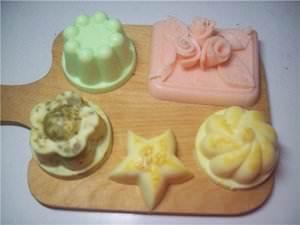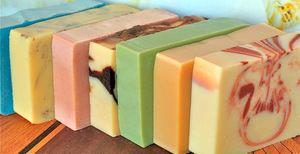The content of the article
Surely every person periodically encounters the appearance of small remnants after using a bar of soap. These small pieces are difficult to use and a pity to throw away, especially if the hygiene product was originally fragrant and good in quality. How to use soap remnants? Thrifty housewives have long found the answer to this question - you can cook soap in the house from the remnants that are in the bathroom.
Moreover, from the old residues it is possible to make not only large bars of a new product, but also to obtain a liquid hygiene product with aromatic additives and pleasant to use. Homemade soap can have several advantages over the store:
- You can decide for yourself what kind of detergent you need, its aroma, composition and exclude the presence of harmful chemicals.
- The presence of healthy ingredients. If you connect fantasy to the manufacturing process, then in the future soap you can add a variety of products and substances: chocolate, perfume, essential oils, creams. Due to this, the product can turn out to be beneficial for the skin and have a unique aroma.
- The real opportunity to save. A new detergent brewed from old residues can help you save a decent amount per year, especially if you have a large family and often need to buy various detergents.
Do not rush to throw away the accumulated remnants of hygiene products, we will be happy to tell you what to do with remnants, and you turn on your creative imagination and try to make your own fragrant and unique product that will not yield to your store’s useful properties.
How to make do-it-yourself liquid soap
There are several simple ways to cook soap at home from remnants. Liquid soap is the easiest to make. You can add any oils or perfumes, milk. In order to avoid disruption of the structure of the product, solids are not recommended.
Ingredients:
- Remnants of toilet soap.
- Hot water.
- Heat-resistant plastic utensils (bottle).
- Grater.
- Bottle for the finished soap.
 Rub remnants on a fine grater and pour them into the prepared bottle. The smaller they are, the faster they dissolve. Small pieces should occupy a little more than half the bottle.
Rub remnants on a fine grater and pour them into the prepared bottle. The smaller they are, the faster they dissolve. Small pieces should occupy a little more than half the bottle.
Pour hot water into this bottle and shake vigorously. Wait for the mixture to dissolve, remembering to shake it periodically. A thick soapy mixture can form in about 12 hours or a little longer, it all depends on what remnants were used to produce the liquid product.
After the soap chips have completely dissolved, you can add milk or some kind of butter to the mixture. Shake well. The finished liquid product can be poured into a beautiful bottle to start using. You can watch the manufacturing process on the video.
How to make a solid soap
How to turn soap bars into a whole bar of soap? Making solid detergent is a very interesting and creative process. For example, you yourself can come up with a shape, smell, composition, color for a future product. Using food coloring, you can give the soap any color, achieve an interesting shape with the help of baby molds, and if you want to make soap with a scrub, ground coffee added to your new hygiene product will help you with this.
Soap from remnants
This soap can be made using the remnants of old soaps of different varieties and hot water.
Ingredients:
- Remnants.
- Hot water.
- Mold for soap.
- Vessel with a lid.
Rub the rest of the hygiene product on a grater and pour it into a small saucepan or other container. Then pour hot water there. Cover and wait for the soap chips to completely dissolve. Remember to periodically stir the composition.
 When the remnants are completely dissolved, pour the resulting mixture into the prepared molds. Before this, you can add any additional ingredients to the soap solution: oils, creams, flavorings.
When the remnants are completely dissolved, pour the resulting mixture into the prepared molds. Before this, you can add any additional ingredients to the soap solution: oils, creams, flavorings.
Now you need to put the molds for 2 days in the refrigerator. If you decide to make a soap scrub, then ground coffee must be added to the mixture when it becomes thick. After adding coffee, you need to mix everything well and put back in the cold. In 2-3 days it will be ready.
How to cook soap from remnants using a microwave
You can prepare a detergent in the microwave, it is very fast and simple. It is only necessary to take into account the fact that many types of soap contain a large number of strong flavors and there is a possibility that subsequently warmed food may be soaked in the smell of perfumes. If you agree to put up with this, then you can proceed with the manufacture of this product in the microwave.
Ingredients:
- Utensils for the microwave.
- Remnants.
- Additional ingredients - milk, perfume, oils.
Rub the soapy pieces on a fine grater. Then pour them into a microwave-safe dish and add some hot water. Cover and microwave.
 In an electric oven, set the power to about 600 watts and run the program for 30 seconds. Then you need to get the soap solution, mix and put in the microwave again for 15 seconds. Then get it again and stir. These steps must be repeated until the soap chips are completely dissolved. It is very important to ensure that the mixture does not boil.
In an electric oven, set the power to about 600 watts and run the program for 30 seconds. Then you need to get the soap solution, mix and put in the microwave again for 15 seconds. Then get it again and stir. These steps must be repeated until the soap chips are completely dissolved. It is very important to ensure that the mixture does not boil.
When the solution is ready, you can add milk or fragrant oil to it, mix, then pour into molds and refrigerate for 2 days.
Multi-colored soap
Do not know where to put the remnants? You can prepare a beautiful and original detergent from multi-colored pieces, for this they need to be cut.
Ingredients:
- Remnants of different colors.
- Cookie cutters.
- Alcohol.
Take colored remnants and cut some of them into small pieces, and the rest into large pieces. Then they will need to be mixed and copiously sprinkle with alcoholso that they stick together.
Then in a separate form you need to pour the melted and transparent soap. Now add sticky colored pieces there.
After everything is completely dry, the finished bar must be removed from the mold and cut into pieces of the desired size.
Useful Tips
There are several important points when preparing a product that you should not forget about:

- It happens that an unpleasant odor is produced during cooking, but it is not recommended to use numerous fragrances because of this. When the soap has cooled, the aroma will change. If you use essential oils in the preparation, you need to add no more than 10-12 drops.
- It is important to remember that when adding natural ingredients to the product, such as milk, lemon peel or orange, its shelf life may be limited.
- When cooking, you can use silicone baking tins. In hardware stores, special forms for soap makers are also sold.
- If during cooking the solution turned out to be too thick, it is diluted with water or infusion from various herbs.
- Very old and hard soap residues can be broken with a hammer.
- If the solution is too liquid, add 20 grams of sugar to it and it will become thick.
- Useful hygiene products for your skinif you add dry lavender, peppermint to the heated solution. In summer, you can use fresh herbs for this: chamomile, St. John's wort, lemon balm and others.
- It is not recommended to use chemical dyes in the manufactureit’s better to use some kind of food for these purposes.
- Brown color can be obtained, adding to the cocoa solutionand if it’s not there, you can also have coffee, red will turn out when you add beetroot juice, if you want yellow, add saffron or calendula.
So you can decide what to do with soap remnants, all of the above methods for making home soap will help to get a fragrant and beautiful hygiene product.

